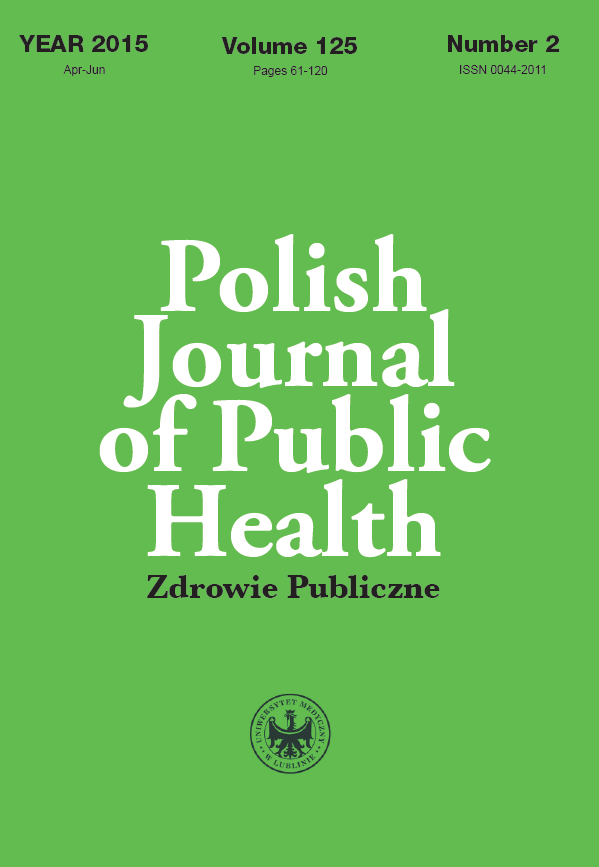The impact of antiepileptic drugs on the condition of the oral cavity in children and youth affected with epilepsy
DOI:
https://doi.org/10.1515/pjph-2015-0035Keywords:
children, youth, CPITN, OHI-S, antiepileptic drugs.Abstract
Introduction. Epilepsy is one of the most common neurological disorders. Epileptic patients taking antiepileptic pharmaceuticals often suffer from hypertrophic changes in gums. It is well established that dental hypertrophies within the alveolar tissue appear more often in children and young people being treated for epilepsy than adults.
Aim. The aim of the study was to determine the influence of antiepileptic drug therapy on the oral cavity of both children and young people suffering from epilepsy.
Material and methods. The investigation consisted of a clinical examination and a questionnaire looking at 107 individuals of both sexes, all aged between 6 and 18. They were all residents of the Lublin region. The study looked at the individuals residing in the Social Care Center in Lublin and patients treated at the Children’s Clinical Hospital in Lublin. The oral analysis included an examination of hard tissues, the state of oral hygiene according to Green and Vermillion (OHI-S), periodontal treatment needs (CPITN), status of gums and mucosal membrane pathological assessment of the oral cavity and determination of developmental disturbances of teeth (intensity of tooth decay expressed as DMFt).
Results. The patients who took antiepileptic drugs had greater treatment needs in tissues of periodontium – determined by the value of CPITN index – (1.68±0.60), unlike those subjects who had not taken any medicine (0.96±0.29), (p=0.0001; Z=-3.20). It was stated that the value of the DMFt index had been significantly higher in those subjects who had been taking antiepileptic medicines (6.80±5.16), unlike the subjects not taking medicine (4.65±3.72), (p=0.02; Z=2.40). In subjects taking antiepileptic drugs, the OHI-S index was significantly higher (2.50) unlike those subjects who had not taken any medicine (1.53), (p=0.0001; Z=4.92).
Conclusions. The findings demonstrate that the hard dental tissues in children taking antiepileptic drugs require much more care. They have a higher simplified index of oral hygiene and higher index for periodontal treatment needs. Disturbances related to oral mucosal cavity and dental abnormalities occurred more frequently in children ingesting antiepileptic agents.
References
1. Panek H, Sobolewska A, Kleczyk M, et al. Pacjent z epilepsją w gabinecie stomatologicznym. Protetyka Stomatol. 2007;57:171-5.
2. Borowicz-Andrzejewska E. Periodontal condition and level of oral hygiene in children treated with carbamazepine and valproic acid. Czas Stomatol. 1999;50:576-81.
3. Lin K, Guilhoto L, TargasYacubian E. Drug – induced Gingival Enlargement. Part II. Antiepileptic drugs: Not only phenytoin is involved. J Epilepsy Clin Neurophysiol. 2007;13:83-8.
4. Prasad VN, Chawla HS, Goyal A, et al. Incidence of phenytoin induced gingival overgrowth in epileptic children: a six month evalua¬tion. J Indian Soc Pedod Prev Dent. 2000;20:73-80.
5. Szpringer-Nodzak M, Wochna-Sobańska M. Stomatologia wieku rozwojowego. Warszawa: PZWL; 2006. p. 251-73.
6. Karolyhazy K, Kivovics P, Fejerdy P, Aranyi Z . Prosthodontic status and recommended care of patients with epilepsy. Prosthet Dent. 2005;93:177-82.
7. Borowicz-Andrzejewska E. The occurence of gingival hyperplasia in children treated for epilepsy with carbamazepine and valproic acid. Epilepsia. 1996;37:694-7.
8. Gurbuz T. Oral health status in epileptic children. Pediatr Int. 2010;52: 279-83.
9. D’Souza W, O’Brien TJ, Murphy M, et al. Toothbrushing-induced epilepsy with structural lesions in the primary somatosensory area. Neurol. 2007;68:769-71.
Downloads
Published
Issue
Section
License
Copyright (c) 2015 Polish Journal of Public Health

This work is licensed under a Creative Commons Attribution-NonCommercial-NoDerivatives 3.0 Unported License.


